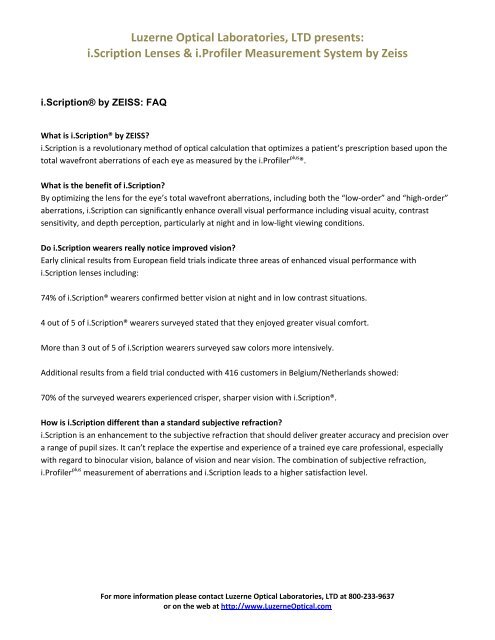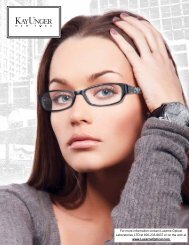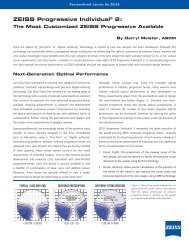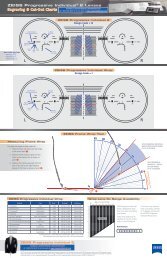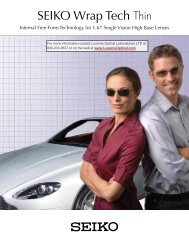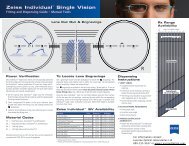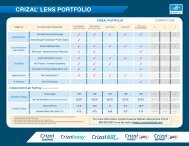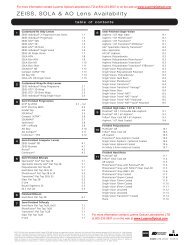Luzerne Optical Laboratories, LTD presents: i.Scription Lenses & i ...
Luzerne Optical Laboratories, LTD presents: i.Scription Lenses & i ...
Luzerne Optical Laboratories, LTD presents: i.Scription Lenses & i ...
You also want an ePaper? Increase the reach of your titles
YUMPU automatically turns print PDFs into web optimized ePapers that Google loves.
<strong>Luzerne</strong> <strong>Optical</strong> <strong>Laboratories</strong>, <strong>LTD</strong> <strong>presents</strong>:i.<strong>Scription</strong> <strong>Lenses</strong> & i.Profiler Measurement System by ZeissHow does i.<strong>Scription</strong> differ from other wavefront prescriptions?i.<strong>Scription</strong> differs from competing systems in several important ways:1. i.<strong>Scription</strong> employs a proprietary prescription optimization algorithm developed by vision scientists at Carl ZeissVision (patent pending)2. i.<strong>Scription</strong> incorporates the eye care professional’s subjective refraction during the calculation process.3. i.<strong>Scription</strong> lenses are calculated and manufactured to one‐hundredth of a diopter (0.01 D).4. i.<strong>Scription</strong> is available on all a full range of customized lens designs and materials from ZEISS.Do lenses using i.<strong>Scription</strong> correct the high‐order aberrations of the eye?It is not possible to correct the high‐order aberrations of the eyes using spectacle lenses, because the eyes areconstantly in motion behind the lenses. However, i.<strong>Scription</strong> optimizes the refraction values by considering theeffects of the high‐order aberrations of the patient’s eyes on vision quality. The resulting lenses are still defined bystandard values such as sphere, cylinder, axis, and add.What lenses may be ordered with i.<strong>Scription</strong>®?i.<strong>Scription</strong> is available on the Zeiss 100% Customized portfolio; offering a Good, Better, Best selection inprogressive designs and a Better and Best design in Single Vision. Most of these lenses have a VSP code associatedwith them. i.<strong>Scription</strong> is compatible with all materials and treatments available within this portfolio.Does i.<strong>Scription</strong> work with any other brand of lens?Only Carl Zeiss Vision has the proprietary calculation engine and the proprietary manufacturing process requiredto create ultra‐precise lenses using i.<strong>Scription</strong>.What is the difference between a conventional spectacle prescription and i.<strong>Scription</strong>?Conventional spectacle prescriptions are typically determined using refractor‐head and trial‐frame lenses usingvarious subjective refraction techniques that may be influenced by the presence of high‐order ocular aberrations,rounding errors due to the use of one‐quarter diopter lenses, and normal variations in subjective responses.i.<strong>Scription</strong> is a “wavefront‐guided” spectacle correction that is optimized based upon both the low‐order and highorderaberrations of the. i.<strong>Scription</strong> sphere and cylinder powers are calculated using a proprietary algorithm thatmaximizes vision quality to the nearest one‐hundredth diopter in the presence of both low‐order and high‐orderaberrations in order to deliver vision corrections with greater precision and accuracy in more viewing conditions,including twilight and nighttime vision.Each i.<strong>Scription</strong> is also reconciled against the subjective refraction to ensure that deliberate modifications to theobjective refraction—to ensure equal stimulus to accommodation for instance—are maintained in the final visioncorrection. i.<strong>Scription</strong> lenses are designed and fabricated using precision free‐form surfacing equipment andFor more information please contact <strong>Luzerne</strong> <strong>Optical</strong> <strong>Laboratories</strong>, <strong>LTD</strong> at 800‐233‐9637or on the web at http://www.<strong>Luzerne</strong><strong>Optical</strong>.com
<strong>Luzerne</strong> <strong>Optical</strong> <strong>Laboratories</strong>, <strong>LTD</strong> <strong>presents</strong>:i.<strong>Scription</strong> <strong>Lenses</strong> & i.Profiler Measurement System by Zeisstechnology patented by Carl Zeiss Vision.What is i.Profiler plus ®?i.Profiler plus is a sophisticated, full‐featured “3‐in‐1” system that incorporates the industry‐leading ATLAS 9000corneal topographer, wavefront aberrometer, and autorefractor. The i.Profiler plus quickly and easily measures theocular wavefront aberrations and refractive status of the eye as well as the topography and aberrations of thecornea. These measurements can also be presented graphically in an extensive array of contour maps and visionsimulations.What is the purpose of i.Profiler plus ?The i.Profiler plus offers a variety of diagnostic capabilities that are invaluable tools in a variety of clinicalapplications: evaluating the complete refractive status of the eye, including low‐ and high‐order wavefrontaberrations; fitting soft and rigid contact lenses; monitoring ocular disease processes; and managing or comanagingrefractive and surgical interventions. Ocular wavefront data captured by the i.Profiler plus is also used tocalculate an i.<strong>Scription</strong>, which is a wavefront‐guided spectacle correction that offers enhanced visual performanceover a range of viewing conditions.What are wavefront aberrations?Wavefront aberrations represent an increasingly common technique for characterizing the focusing errors of thehuman eye and other optical devices. Wavefront aberrations are generally categorized as either low‐orderaberrations or high‐order aberrations. Low‐order aberrations are associated with the traditional refractive errorsof the eye, or the sphere power and cylinder power of the prescription. High‐order aberrations represent moresubtle focusing errors that can also affect vision quality, particularly at larger pupil sizes. Although it is notpossible to correct the high‐order aberrations of the eye with a spectacle lens, the sphere and cylinder powers ofa traditional prescription can be fine‐tuned to minimize the effects of high‐order aberrations on vision quality.How do high‐order aberrations impact vision?High‐order aberrations create additional image “noise” that degrades vision quality and reduces retinal imagecontrast, particularly at larger pupil sizes. High‐order aberrations can also produce certain glare phenomenaaround lights and other bright objects at night, including “halo” and “starburst” patterns.What technology does the i.Profiler plus use to measure the aberrations of the eye and cornea?The i.Profiler plus measures wavefront aberrations using a Shack‐Hartmann wavefront sensor. It measures thecorneal topography of the eye using a videokeratography system with an integrated Placido disk.Why are the results from the i.Profiler plus superior to those of a conventional autorefractor?Conventional autorefractors can only measure the overall refractive power of the eye, typically over a small,central region of the pupil. They cannot account for local variations in refractive power across the eye due to thepresence of high‐order aberrations. The i.Profiler plus measures the distribution of the refractive power across theFor more information please contact <strong>Luzerne</strong> <strong>Optical</strong> <strong>Laboratories</strong>, <strong>LTD</strong> at 800‐233‐9637or on the web at http://www.<strong>Luzerne</strong><strong>Optical</strong>.com
<strong>Luzerne</strong> <strong>Optical</strong> <strong>Laboratories</strong>, <strong>LTD</strong> <strong>presents</strong>:i.<strong>Scription</strong> <strong>Lenses</strong> & i.Profiler Measurement System by Zeissentire pupil, permitting more accurate calculation of the entire refractive status of the eye.How long does the measuring process take?The complete measuring process takes less than 1 minute for both eyes.How difficult is the device to operate?The process is fully automatic and can easily be performed by staff with minimal training.Can the i.Profiler plus be used to measure children?Yes. Thanks to its measuring speed, the i.Profiler plus is ideal for the measurement of children who are capable ofmaintaining fixation on the test image for a short period of time.What data does the i.Profiler plus collect in keratometer mode?The i.Profiler plus measures the central and peripheral corneal radii as well as the complete corneal topography ofthe eye by means of a videokeratography system with integrated Placido projector.Is the i.Profiler plus required to prescribe i.<strong>Scription</strong> lenses?Because i.<strong>Scription</strong> relies on measurements of the wavefront aberrations of the eye, a wavefront‐sensingaberrometer is required. Currently, the i.Profiler plus is the only aberrometer that has been qualified by Carl ZeissVision to work with the i.<strong>Scription</strong> calculation engine.For more information please contact <strong>Luzerne</strong> <strong>Optical</strong> <strong>Laboratories</strong>, <strong>LTD</strong> at 800‐233‐9637or on the web at http://www.<strong>Luzerne</strong><strong>Optical</strong>.com


